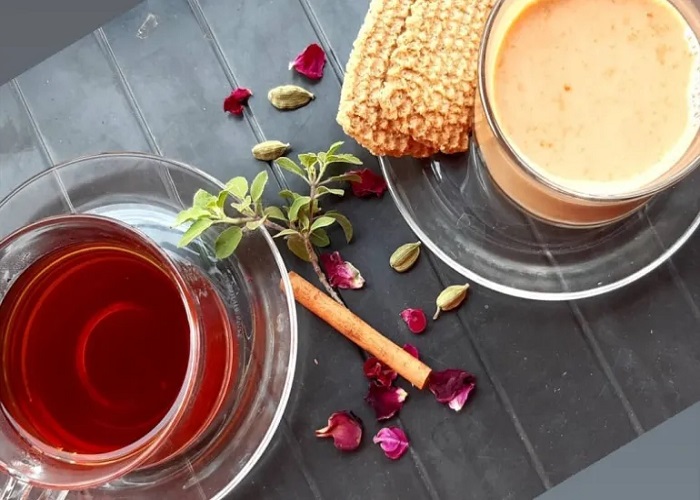
Indians took the tea the British were marketing to them, added spices, milk and sugar, and transformed it forever.
I remember jumping up to sit on the kitchen counter one afternoon. My five-year-old self wants to watch my mother making chai. She pushes me away from the gas stove but I am indignant and refuse to hop down, although I do move away a bit.
The water bubbles. She adds sugar, then takes a flat steel grater, balances it on the edge of the pot and grates in adrak (ginger).
“Why do we add this?” I ask, watching the shreds fall into the bubbling water.
“Child, I have to hurry I don’t have time for your questions,” she says. I sulk but I know that, being a doctor, she has to get to the hospital on time. I will ask grandma, I tell myself.
The ginger threads dance in the water. Then she adds the tea leaves, turning the contents of the pot brown. Stirring, she adds milk and lets it simmer over a low flame, still stirring. After a few minutes, she removes it from the heat and covers it. I hop down to watch the next step. She strains it in cups, puts them on a tray, and carries it to the dining table.
I run out. I have no interest in tasting it but am proud, boasting to my friends: “I know how to make chai.” By the end of the day, I have memorised the process forever.
I don’t want to ask to taste it because I know if I do, she will dilute it with more milk. “Children should not drink tea,” she would say. I hated that pale milky liquid.
The first time I tasted real chai, I was in grade three. I had scored good marks on a maths test and ran home that August afternoon to share the news with my mother and grandparents as they were having their chai. Basking in the appreciation and pats on my back, I asked if I could have chai. Mother refused, but grandfather smiled and poured some into a cup. I took it and breathed the aroma in deeply. I took one sip, then the second. The creamy, rich beverage warmed my heart and spirit and at that precise moment, I became a chai lover.
I yearned to make chai but wasn’t allowed. “What if you spill the boiling water and get burned,” my grandmother would fret. Finally, when I was in grade five, she reluctantly allowed me to make it under her supervision and soon I was making it alone.
I felt so accomplished, measuring water, grating ginger, and scooping sugar and tea leaves to add to the boiling water. Watching the tea leaves spinning with the ginger. Then adding the milk and watching it lighten the chai and simmer, steeping the flavours. “A good cup of chai needs a slow fire,” I was told, something I follow to this day.

Fast forward a few years, and I am on my way home on a bitterly cold January evening in Indore. The sun is on leave and the wind drills into my bones. I enter a silent, cold apartment – my mother isn’t back from the hospital yet and my grandmother has moved to live with my uncle since my grandfather passed away.
I need chai. Soon, I’m sitting with a hot, steaming cup, sipping it slowly. I close my eyes, savouring the sweet milk, sharp ginger and cinnamon. By then, I was experimenting with spices and adding what felt right at the moment – cinnamon, fennel, green cardamom and more. I would add lemongrass, holy basil and peppercorns if I had a cold or sore throat.
Chai is tea, tea is chai
Chai in India is a drink for no reason and for every reason, morning, afternoon, evening and night. It lifts your spirits while studying for the maths paper or learning chemistry formulas. It spices college gossip and fans rumours. A welcoming or parting drink, to convince friends and family to stay longer to share more stories.
It brings everyone together. It is served in homes, board meetings, college canteens, cafes and at weddings. “Chalo chai ho jaye,” (Let’s have tea) is heard every day.

Tea is chai in India. When, where, and how the first cup of chai was brewed is still up for debate, but the stories from our elders give us an idea about the evolution of this delicious, addictive beverage.
Prerna Kumar, founder of ChaiVeda and purveyor of medicinal blends, says: “The early reference to tea is found in the Buddhist texts where the monks drank some kind of tea while fasting and meditating.
“They made tea from foraged tea leaves and perhaps added certain flowers to the decoction to help them feel calmer.”…
By Nupur Roopa – Aljazeera









